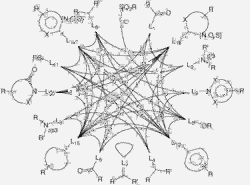BRICS Datasets
Description
The BRICS ruleset[1] allows the modeling of chemical spaces based on prominent chemical motifs of known inhibitors and commercially available compounds.
BRICS consists of a representation of chemical environments for generating and recombining fragments based on a comprehensive and easily adaptable set of rules.

BRICS can serve as a basis for various molecular design objectives, including
- structure- and descriptor-based de novo design
- similarity searching and library design
- fragment-based molecular design
Scope and Limitations
- We provide three differently sized fragment collections based on the BRICS model.
- In this context, a fragment is a small molecule with explicitly modeled attachment points ('links').
- We further provide a corresponding set of rules for the recombination of fragments.
- We include input data files for the structure-based de novo design program FlexNovo[2] and for combinatorial similarity searching with FTrees-FS[3].
- The fragments can also be used 'as is' and for docking with, for example, JAMDA.
Availability
To obtain BRICS, please read and accept the disclaimer for details on usage, privacy, data storage, and related issues. It is available at https://www.zbh.uni-hamburg.de/forschung/amd/datasets/brics-datasets/brics-licence.html.
Please note that the BRICS fragment collections are for internal use only and must not be redistributed.
We provide three fragment collections from increasingly large intersections of fragments derived with the BRICS model from the World Drug Index[4] and the ZINC Drug-Like subset[5]. These collections are publicly available in MOL2 format. In addition, we provide input data files (FSF) for direct use with FlexNovo and FTrees-FS.
| fragment set/space | #fragments | last update | data files |
| BRICS_2008_4k | 4800 | 26.09.2008 | MOL2 and FSF |
| BRICS_2008_9k | 9344 | 26.09.2008 | MOL2 and FSF |
| BRICS_2008_20k | 22,343 | 26.09.2008 | MOL2 and FSF |
Acknowledgement
We are grateful to all partners of the NovoBench project and the German Federal Ministry of Education and Research (BMBF) for partial funding (grant 313324A).
[1] Degen, J.; Wegscheid-Gerlach, C.; Zaliani, A.; Rarey, M. On the Art of Compiling and Using 'Drug-Like' Chemical Fragment Spaces. ChemMedChem 2008, 3 (10), 1503-1507. DOI: https://doi.org/10.1002/cmdc.200800178
[2] Degen, J.; Rarey, M. FlexNovo: Structure-Based Searching in Large Fragment Spaces. ChemMedChem 2006, 1 (8), 854-868. DOI: https://doi.org/10.1002/cmdc.200500102
[3] Rarey, M.; Stahl, M. Similarity Searching in Large Combinatorial Chemistry Spaces. J Comput Aided Mol Des 2001, 15 (6), 497-520. DOI: https://doi.org/10.1023/a:1011144622059
[4] World Drug Index, Version 2004, Thomson, Philadelphia, PA (USA), 2004.
[5] ZINC Database. https://zinc.docking.org/
